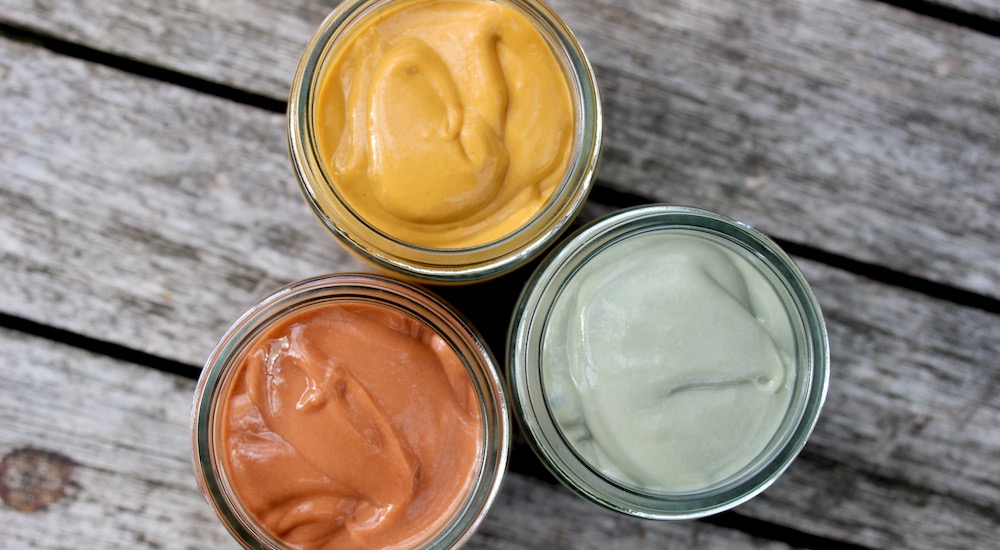Home / How-to videos / Clay masks
Clay masks
Hydrating mineral clay mask recipe

Clays are rich in minerals, such as iron, magnesium and potassium, and well known for their cleansing and purifying properties. They are said to work wonders to stimulate, reinvigorate and rejuvenate cells and tissues, making them an ideal ingredient for skin care and natural beauty products.
This recipe is a bit more advanced than your average "clay + water = mask" and makes for a stunning face mask full with loads of skin nourishing ingredients. It also makes great gifts as it's fully mixed, preserved and ready to go!
You can also adjust it to your own wants a needs, pictured, we've used yellow clay, green clay and red clay, and have chosen essential oils to suit (yellow = frankincense, green = chamomile, red = rose geranium) but you can use any combination of clay and essential oil you like.
About the ingredients
Check out our blog post How Different Clay Benefit the Skin to learn more about different coloured clays and which is right for your skin.
Hyaluronic acid (HA) is a molecule that can attract up to 1000 times its weight in water. It occurs naturally in the body and generally decreases with age, which is why most skin types – even oily and acne-prone skins – respond so well when it's introduced artificially. In the skin it exists in the epidermis and keeps the skin hydrated and supple due to its high water retention ability.
Niacinamide also known as vitamin B3, works with the natural substances in your skin and is said to help regulate sebum production, improve the appearance of enlarged pores, reduce fine lines and wrinkles, fade age spots and hyperpigmentation and brighten the complexion. Niacinamide's anti-inflammatory properties can make it a good treatment for skin inflammations, such as acne, as it is relatively non-irritating compared with other acne treatments. This makes it an especially attractive option for people with dry or sensitive skin.
Hydrolyzed quinoa is considered a complete protein, packed with vitamins and minerals as well seventeen amino acids, including all eight essential amino acids, which can help repair damage and form a protective barrier, bind moisture and provide nutrients for the skin.
Unrefined shea butter contains an abundance of healing ingredients, including vitamins, minerals, proteins and a unique fatty acid profile, and is a superior active moisturiser.
Recipe
Makes 100g - use our Batch Size Calculator to easily adjust the volume of your batch.
Ingredients
Phase A
65.90g | 65.90% Water
0.10g | 0.10% Sodium phytate
Phase B
7g | 7% Glycerin, certified organic
0.40g | 0.40% Xanthan gum
Phase C
4g | 4% Emulsifier O
3g | 3% Shea butter, unrefined, certified organic
1.50g | 1.50% Stearic acid
Phase D
4g | 4% Niacinamide
6g | 6% Clay of your choice
3g | 3% Hydrolysed quinoa
3g | 3% Hyaluronic acid solution 1%
1g | 1% Geogard 221
0.60g | 0.60% Vitamin E
0.50g | 0.50% Essential oil of your choice
Method:
- Measure out phase A.
- Combine phase B to form a slurry. Add to phase A, stirring until it forms a gel.
- Heat phase A/B to 60°c.
- Combine phase C and add to the heated phase A/B, whisking until until the waxes are melted and it forms a smooth mixture.
- Allow to cool to under 40°c.
- Add phase D and stir until combined.
- Allow to cool to under 25°c then check/adjust your pH to 5.5 - 6. It will get thicker over the next few hours so leave it a day and give it one final stir before potting.
- 50ml pots are a good fit. While the mixture makes 100g some of the volume is lost due to water evaporation so you may want to double or triple your mixture if you're looking to make multiple pots.
Apply a thick layer to face. Leave on for 10 - 30 minutes, it will go tacky but not fully dry. Wash off with warm water and face cloth. It can help to wash off in the shower.
